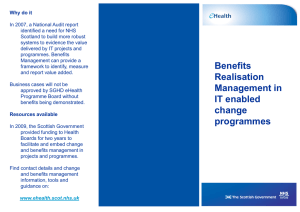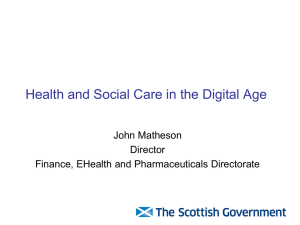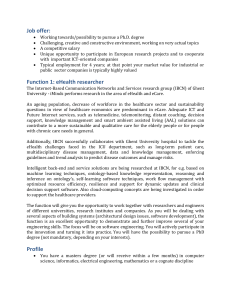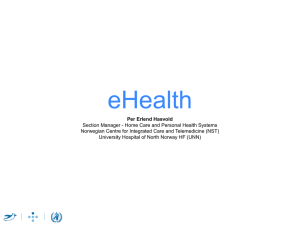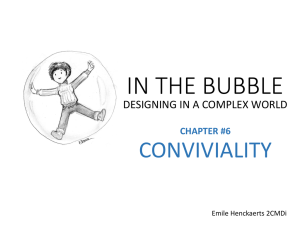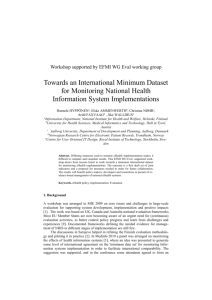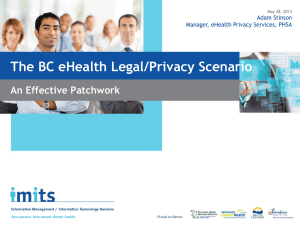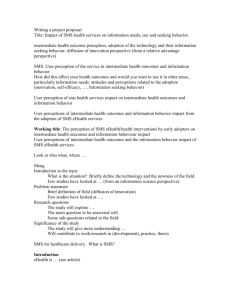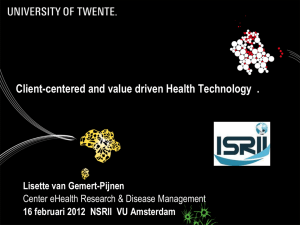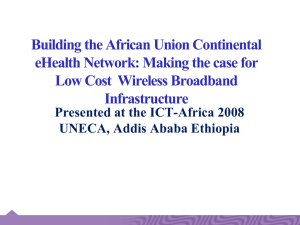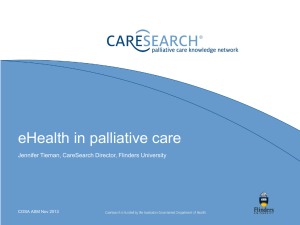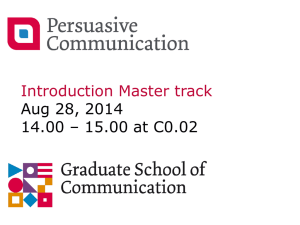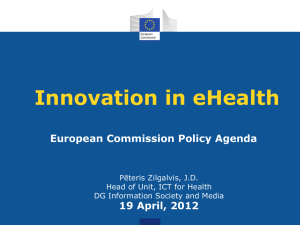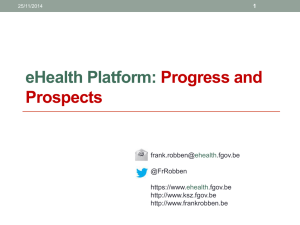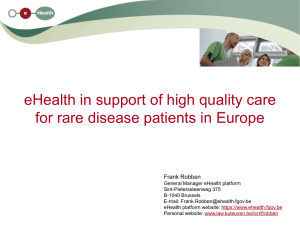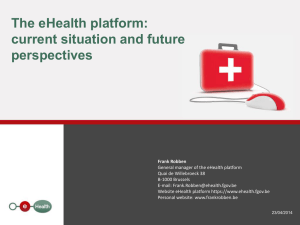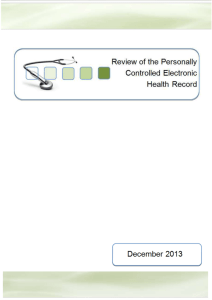focus on helping bring about real service - E
advertisement
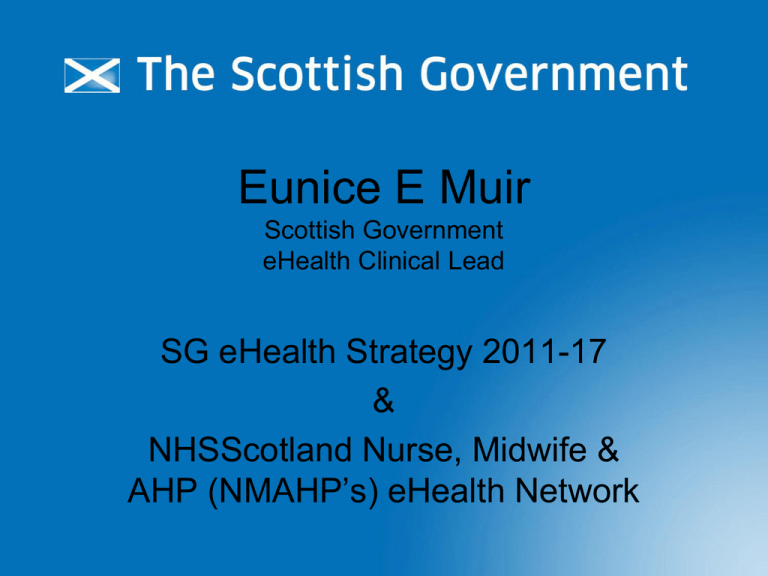
Eunice E Muir Scottish Government eHealth Clinical Lead SG eHealth Strategy 2011-17 & NHSScotland Nurse, Midwife & AHP (NMAHP’s) eHealth Network LEASONS FROM eHealth HISTORY • If you computerise a mess, the outcome will be a bigger mess • Focus on improvement, not IT for the sake of it • Try to spend 25% of project costs on IT • Need top down and bottom up approach SG eHealth Strategy 2011-17 •six national strategic aims •each reflected in local Health Board eHealth Plans •Supported by common progress measures Time to exploit previous investments – focus on helping bring about real service improvement NMAHP’s/eHealth/Care Delivery • It is time to build what NMAHP’s want • NMAHP’s do not want to be passive consumers of technology • Establish partnerships around better functionality and devices • Facilitate adoption of technology as a constituent of quality and safety measures eHealth governance NMAHP eHealth Network •Established July 2012 •Integrated within eHealth structure •NMAHP representation at Assoc. Director level from Boards, HEI’s, Prof Bodies •ToR’s approved •Meets quarterly via Teleconf and face-to-face •Leadership Summit + Workshop Learning Event •Links to 5 Countries eHealth Partnership STRATEGIC eHEALTH AIMS To use information and technology in a coordinated way to: 1. Maximise efficient working practices, minimise wasteful variation, bring about savings and value for money 2. Support people to communicate with NHSS, manage their own health and wellbeing, and to become more active participants in the care and services they receive 3. Contribute to care integration and to support people with long term conditions Patient Portals Patient Portals Email and SMS Websites Improving Information One-way communication (NHS to patient/person) Patient Portals Self Check-in Kiosks Appointments and repeat prescriptions Email and SMS Reminders Two-way communication (to & from patient/person) Home Monitoring Peer support Social Media Patient Portals Online forums co-created Key Information Summary • e-form, mostly filled in automatically with information held in GP practice electronic patient record • co-created by GP practice with patient • targeted for people most likely to need anticipatory/ outof-hours care • available electronically to NHS 24, ambulance, community teams, A&E KIS content Section 1 – “Special Note” – Free text field of 2048 Characters – Expiry Date – Patient, Carer and involved staff details – Other demographics (eg. next of kin) Section 2 – Current Situation – Medical Information and Diagnosis – ACP / Self Management Plan agreement – Home Oxygen Section 3 – Care and Support details – Homecare support – Incapacity / Guardianship – Power of Attorney Section 4 – Resuscitation – DNACPR – CYPADM (Children Resuscitation) – Current and Preferred Place of Care – any special instructions Status: all prep work done; roll-out from April; part of GP contract Future: Patient/carer access via web/ App, with section for self completion? Extensible to other contributors to care? STRATEGIC eHEALTH AIMS To use information and technology in a coordinated way to: 4. Improve the availability of appropriate information for healthcare workers and the tools to use and communicate that information effectively to improve quality 5. To improve the safety of people taking medicines and their effective use 6. Provide ‘near real-time’ management information in support of local decision making Data Sharing Technologies Board • • • Representatives from Local Authorities and Health Boards. Membership will be extended to include other public bodies (eg Police) and Third Sector Transition from national “one size fits all” approach to a series of locally led initiatives Three strands of business:– – – stewardship of the legacy National eCare IT promote innovative and pragmatic information sharing initiatives that result in better outcomes for service users develop and oversee the implementation of the Health & Social Care IT Strategy. clinical portal • ‘virtual’ electronic patient record – not about large national database • electronic window to information held in different places, fetched and viewed by clinician on an as-required basis Greater Glasgow & Clyde NHS Lanarkshire trial • ECS accessed for 405 admissions • for 67 patients (22%) ECS contained additional info for 23 (35%) of those patients potential harm was avoided courtesy of ECS access + a separate comparison of 30 referral letters - drugs vs. actual current prescription - found 119 discrepancies Where they were…… • Very supportive of Scottish Patient Safety Programme work streams (General Ward, Peri-Operative, Medicines Management, Critical Care and Leadership) and Leading Better Care Clinical Quality Indicators (Falls, Pressure Ulcers, and Food, Fluid and Nutrition) • But meant laborious manual data collection by clinical staff • Feedback lags – needed more real time analysis and reporting of data directly to front line staff. • got front-line clinical staff to develop local meaningful indicators • developed LANQIP - web-based tool • supports the collation, analysis, real-time reporting and feedback • gives feedback to clinical teams regarding clinical practice, tailored to their needs • Increased efficiency and “buy in” from clinical teams by eliminating manual burden • Improve data quality through the increased sense of data ownership and how it relates and impacts clinical practice Range of feedback reports The future? More of the same… but with increasing role for mobile devices Eunice E Muir Scottish Government eHealth Clinical Lead SG eHealth Strategy 2011-17 & NHSScotland Nurse, Midwife & AHP (NMAHP’s) eHealth Network
